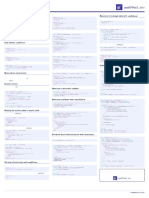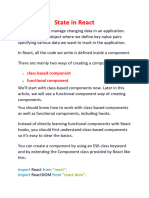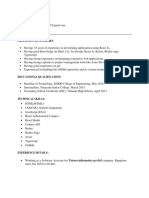0% found this document useful (0 votes)
16 views14 pagesReact Hooks
The document provides an overview of various React hooks, including useState for managing state in functional components, useEffect for handling side effects, and useContext for accessing global state. It also covers useRef for managing DOM references, useMemo for performance optimization, and useCallback for memoizing functions. Additional hooks discussed include useLayoutEffect, useImperativeHandle, useDebugValue, and useId for specific functionalities in React applications.
Uploaded by
Pranav PatilCopyright
© © All Rights Reserved
We take content rights seriously. If you suspect this is your content, claim it here.
Available Formats
Download as PDF, TXT or read online on Scribd
0% found this document useful (0 votes)
16 views14 pagesReact Hooks
The document provides an overview of various React hooks, including useState for managing state in functional components, useEffect for handling side effects, and useContext for accessing global state. It also covers useRef for managing DOM references, useMemo for performance optimization, and useCallback for memoizing functions. Additional hooks discussed include useLayoutEffect, useImperativeHandle, useDebugValue, and useId for specific functionalities in React applications.
Uploaded by
Pranav PatilCopyright
© © All Rights Reserved
We take content rights seriously. If you suspect this is your content, claim it here.
Available Formats
Download as PDF, TXT or read online on Scribd
/ 14





















































































